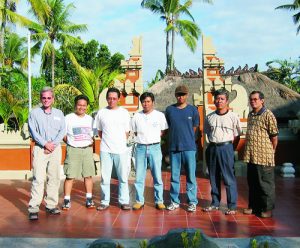After warning about the tragic tsunami in the Indian Ocean, a BYU geology professor turns his attention to the Wasatch Front.
As a trembling Indonesia settled into a moment of peace in the minutes after last December’s earthquake, the ocean waters receded. This should have been a foreboding sign, but thousands on the island of Sumatra ignored the quake’s warning and stayed on the beach or explored the exposed tide pools. Fifteen minutes later, the tsunami hit.
As the days pass, the death toll continues to climb to more than a quarter of a million. Yet the people on one island in that region stand spared. The island of Simeulue, the land closest to the earthquake’s epicenter, was expected to see the same devastation as its neighboring island, Sumatra. While most of the buildings on Simeulue were destroyed, only around 200 people died as a result of the earthquake and tsunami compared to nearly 200,000 on the island of Sumatra.

Professor Ron A. Harris, who, in 1997, had predicted an earthquake would take place in the area, explains this phenomenon saying, “The knowledge of what to do was passed from generation to generation. It was one of the most important things that the local people did when they talked and told stories, and it saved thousands of people in Simeulue.”
The devastation in Sumatra was due largely to a lack of education, says Harris. Unlike the people of Simeulue, most in Sumatra did not run for higher ground after they felt the earthquake and, as a result, many died in the tsunami that followed. Harris says the earthquake could have been an early warning system for the subsequent tsunami, but “few knew what to do.”
The unnecessary deaths of so many people has stirred up anxiety among those who reside in similar danger zones. But Harris notes that this awareness alone will not alleviate the effects of such disasters. He cites the Wasatch Fault Zone—which runs beneath two of Utah’s major cities, Salt Lake City and Provo—as an active fault set to snap any day. The fault segments, which cyclically release their tension about every 1,000 years, are overdue. Salt Lake City’s segment has not slipped for 1340 years (±100), the Nephi, Utah, segment, for 1,400 years. The possibility that these faults will slip increases each day, yet little has been done to prepare for this event even though the knowledge and technology are available.
Harris calls for a change of perspective. “Unfortunately,” he says, “many of the decisions people make are based solely on economics and politics and not on what’s good for the overall population.” With today’s technology, scientists can calculate where an earthquake will take place and how large it will be. They can also tell when previous earthquakes occurred and if the location is overdue for another event. Harris states, “With that amount of knowledge, policy makers should be able to pass legislation and get things moving, but it seems to stall because of the lack of immediacy.”
Harris worries that many Wasatch Front residents live each day with the passive hope that the event will not occur immediately, and thus little is done to prepare. Many of Utah’s homes, especially unreinforced masonry structures built over 20 years ago, do not fit seismic code. Thousands of people reside in houses that are not built to withstand an earthquake’s force. “We can’t live in denial,” Harris states. “We’ve got to act. If we don’t act quickly, we could regret it like the people of Sumatra.”
With the lessons from Sumatra and Simeulue, the residents along the Wasatch Front have the responsibility to get educated and then pass their knowledge on to the next generation. It must begin with active preparation. Harris urges, “There’s no reason why we should allow earthquakes to knock over our homes. We have the technology, we have the knowledge, we have the will to do something about it. To allow earthquakes to terrorize us means that we’re a weak people.”
To learn more about earthquake preparation, go to more.byu.edu/earthquake.









